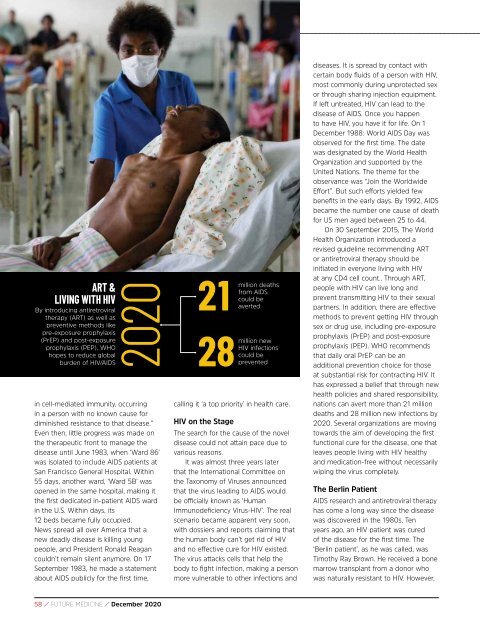Create successful ePaper yourself
Turn your PDF publications into a flip-book with our unique Google optimized e-Paper software.
ART &<br />
LIVING WITH HIV<br />
By introducing antiretroviral<br />
therapy (ART) as well as<br />
preventive methods like<br />
pre-exposure prophylaxis<br />
(PrEP) and post-exposure<br />
prophylaxis (PEP), WHO<br />
hopes to reduce global<br />
burden of HIV/AIDS<br />
<strong>2020</strong><br />
in cell-mediated immunity, occurring<br />
in a person with no known cause for<br />
diminished resistance to that disease.”<br />
Even then, little progress was made on<br />
the therapeutic front to manage the<br />
disease until June 1983, when ‘Ward 86’<br />
was isolated to include AIDS patients at<br />
San Francisco General Hospital. Within<br />
55 days, another ward, ‘Ward 5B’ was<br />
opened in the same hospital, making it<br />
the first dedicated in-patient AIDS ward<br />
in the U.S. Within days, its<br />
12 beds became fully occupied.<br />
News spread all over America that a<br />
new deadly disease is killing young<br />
people, and President Ronald Reagan<br />
couldn’t remain silent anymore. On 17<br />
September 1983, he made a statement<br />
about AIDS publicly for the first time,<br />
21<br />
28<br />
million deaths<br />
from AIDS<br />
could be<br />
averted<br />
million new<br />
HIV infections<br />
could be<br />
prevented<br />
calling it ‘a top priority’ in health care.<br />
HIV on the Stage<br />
The search for the cause of the novel<br />
disease could not attain pace due to<br />
various reasons.<br />
It was almost three years later<br />
that the International Committee on<br />
the Taxonomy of Viruses announced<br />
that the virus leading to AIDS would<br />
be officially known as ‘Human<br />
Immunodeficiency Virus-HIV’. The real<br />
scenario became apparent very soon,<br />
with dossiers and reports claiming that<br />
the human body can’t get rid of HIV<br />
and no effective cure for HIV existed.<br />
The virus attacks cells that help the<br />
body to fight infection, making a person<br />
more vulnerable to other infections and<br />
diseases. It is spread by contact with<br />
certain body fluids of a person with HIV,<br />
most commonly during unprotected sex<br />
or through sharing injection equipment.<br />
If left untreated, HIV can lead to the<br />
disease of AIDS. Once you happen<br />
to have HIV, you have it for life. On 1<br />
<strong>December</strong> 1988: World AIDS Day was<br />
observed for the first time. The date<br />
was designated by the World Health<br />
Organization and supported by the<br />
United Nations. The theme for the<br />
observance was “Join the Worldwide<br />
Effort”. But such efforts yielded few<br />
benefits in the early days. By 1992, AIDS<br />
became the number one cause of death<br />
for US men aged between 25 to 44.<br />
On 30 September 2015, The World<br />
Health Organization introduced a<br />
revised guideline recommending ART<br />
or antiretroviral therapy should be<br />
initiated in everyone living with HIV<br />
at any CD4 cell count.. Through ART,<br />
people with HIV can live long and<br />
prevent transmitting HIV to their sexual<br />
partners. In addition, there are effective<br />
methods to prevent getting HIV through<br />
sex or drug use, including pre-exposure<br />
prophylaxis (PrEP) and post-exposure<br />
prophylaxis (PEP). WHO recommends<br />
that daily oral PrEP can be an<br />
additional prevention choice for those<br />
at substantial risk for contracting HIV. It<br />
has expressed a belief that through new<br />
health policies and shared responsibility,<br />
nations can avert more than 21 million<br />
deaths and 28 million new infections by<br />
<strong>2020</strong>. Several organizations are moving<br />
towards the aim of developing the first<br />
functional cure for the disease, one that<br />
leaves people living with HIV healthy<br />
and medication-free without necessarily<br />
wiping the virus completely.<br />
The Berlin Patient<br />
AIDS research and antiretroviral therapy<br />
has come a long way since the disease<br />
was discovered in the 1980s. Ten<br />
years ago, an HIV patient was cured<br />
of the disease for the first time. The<br />
‘Berlin patient’, as he was called, was<br />
Timothy Ray Brown. He received a bone<br />
marrow transplant from a donor who<br />
was naturally resistant to HIV. However,<br />
58 / FUTURE MEDICINE / <strong>December</strong> <strong>2020</strong>

















